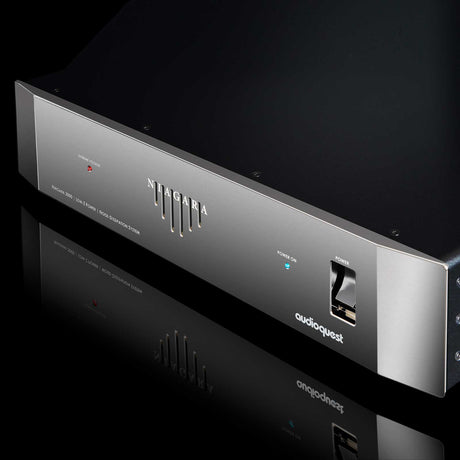
On Bi-Wiring and Power Conditioning
AudioQuest's Niagara 3000 proves to be a first of its kind — the first power conditioner Alex Halberstadt doesn't hate, that is.
CL3/FT4 Câble d'interconnexion audio en vrac classé pour montage mural
Conducteurs en cuivre à grain long solide (LGC)
Le cuivre à grain long solide (LGC) permet un son plus lisse et plus clair que les câbles utilisant du cuivre OFHC (haute conductivité sans oxygène) régulier. Les conducteurs solides empêchent l'interaction des brins, une source majeure de distorsion. La qualité de la surface est critique car un conducteur peut être considéré comme un rail-guide pour les champs électriques à l'intérieur d'un conducteur, et pour les champs magnétiques à l'extérieur du conducteur. Le LGC a moins d'oxydes dans le matériau conducteur, moins d'impuretés, moins de frontières de grain, et des performances définitivement meilleures.
Conducteurs à direction contrôlée
Tous les brins ou conducteurs de métal étirés ont une structure de grain non symétrique, et donc directionnelle. AudioQuest contrôle la variation d'impédance RF résultante afin que le bruit soit évacué loin de l'endroit où il causera de la distorsion. La bonne direction est déterminée en écoutant chaque lot de conducteurs métalliques utilisés dans chaque câble audio AudioQuest. Lorsque cela est applicable, des flèches sont clairement marquées sur les connecteurs pour garantir une qualité sonore supérieure. Pour la plupart des modèles de câbles AQ, les flèches indiquent non seulement la direction qui optimise la directionnalité du métal dans le cadre de la dissipation du bruit, mais indiquent également l'attachement non symétrique du blindage et de la masse afin d'optimiser les performances du système complet. Un aspect fondamental de la technologie de dissipation du bruit multifacette de AudioQuest, les conducteurs à direction contrôlée garantissent que le bruit induit est dissipé et évacué correctement.
Dissipation du bruit par couche métallique
Il est facile d'obtenir une couverture de blindage à 100 %. Empêcher les interférences radiofréquences capturées (RFI) de moduler la référence de masse de l'équipement nécessite la dissipation du bruit d'AQ. Les systèmes de blindage traditionnels absorbent généralement et évacuent ensuite l'énergie du bruit/RF vers la masse du composant, modulant et déformant le plan de masse « référence » critique, ce qui entraîne à son tour une distorsion du signal. La dissipation du bruit « protège le blindage », absorbant et réfléchissant la plupart de cette énergie de bruit/RF avant qu'elle n'atteigne la couche attachée à la masse.
Isolation en mousse à cellules dures
L'isolation en mousse à cellules dures (HCF) garantit une géométrie critique des paires de signaux. Tout matériau solide adjacent à un conducteur fait en réalité partie d'un circuit imparfait. Les matériaux d'isolation des fils et des cartes de circuits absorbent tous de l'énergie. Une partie de cette énergie est stockée puis libérée sous forme de distorsion. L'isolation en mousse à cellules dures est similaire au PE expansé utilisé dans nos câbles Bridges & Falls plus abordables, et est injectée à l'azote pour créer des poches d'air. Parce que l'azote (comme l'air) n'absorbe pas d'énergie et donc ne libère aucune énergie de ou dans le conducteur, la distorsion est réduite. De plus, la rigidité du matériau permet aux conducteurs du câble de maintenir une relation stable tout au long de la longueur du câble, produisant un caractère d'impédance stable et minimisant davantage la distorsion.
Géométrie double équilibrée
Spécifiquement conçue pour les applications à extrémité unique, la géométrie double équilibrée offre une impédance relativement plus faible sur la masse pour une expérience plus riche et plus dynamique. Alors que de nombreux designs de câbles à extrémité unique utilisent un chemin unique pour la masse et le blindage, les designs double équilibrés séparent les deux pour une performance plus propre et plus silencieuse.